
First Flour Mill Builders in Sydney, NSW
1788 to 1810
Researched by Anne and Les Dollin
Singleton Mills homepage > The earliest flour mills of Sydney, NSW > The earliest flour mill builders in Sydney
A critical shortage of mill builders
Large-scale flour mills were urgently needed in the infant colony of Sydney in New South Wales (NSW), Australia, in the late 1700s. However, for the first four years of the colony, nobody was found amongst the free settlers or the convicts who had the specialised skills needed to build and run an efficient, powered, flour mill.
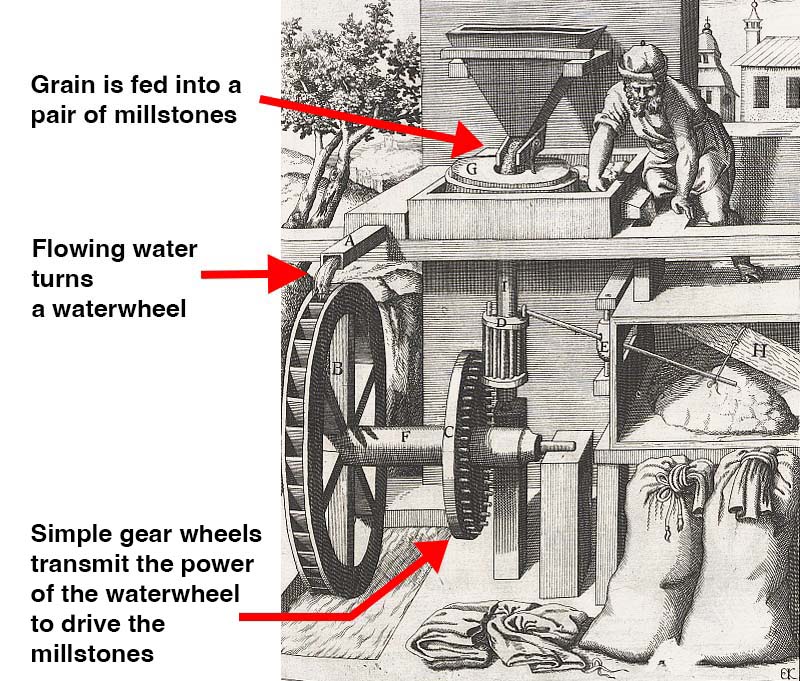
Above, this very simple design for a basic flour mill is powered by a waterwheel. Other basic flour mills could be powered by animals, man-power, or by the wind. However, to build even simple flour mills, such as these, requires specialised knowledge that was unavailable in the early Sydney colony. This drawing is a copy of a scientific illustration, dated 1661, from Deutsche Fotothek.
Governor Arthur Phillip had sent urgent pleas to Britain that the colony needed skilled mill builders. The small hand-mills for milling wheat, which had been supplied to the settlers, had all worn out. They had a couple of pairs of full-sized millstones in the colony, but nobody knew how to build a workable flour mill.
Finally after four years, some progress...
In 1792-1793, a Master-MillwrightA and a Master-Miller were sent out from Britain specifically to build flour mills for the Colony, and then three other promising men were found amongst the convicts.
A: Millwright. A person who designs and builds grain mills, and maintains the machinery in the mill (see drawing below).
HERE ARE THE STORIES OF SYDNEY'S FIRST FIVE FLOUR MILL BUILDERS: – Thomas Allen and James Thorp |
Thomas Allen and James Thorp
Thomas Allen (or Thomas Allan) was a miller who had been employed by the King's Mills at Rotherhithe, of Surrey in England. He was contracted to go to NSW for four years, as a Master-Miller.
James Thorp (or James Thorpe) had stated that he was a millwright employed by the Albion Mill, of Surry in England. He was contracted to go to NSW for three years, as a Master-Millwright.
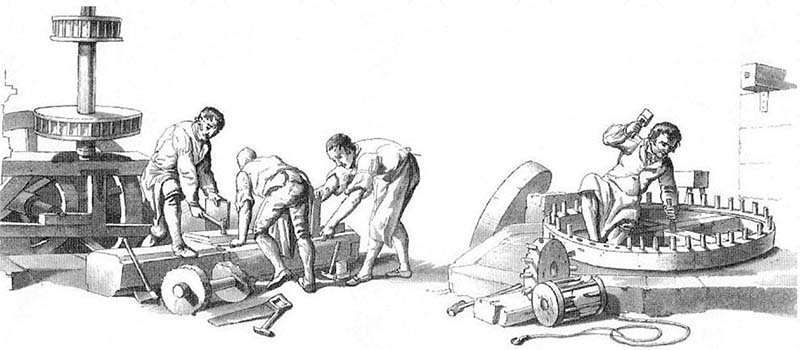
Above, Millwrights repairing the workings of a mill. This 19th Century illustration shows the kinds of specialised skills that a Millwright required. Drawings by WH Pyne 1806 in 'A picturesque delineation of the arts, agriculture, and manufactures of Great Britain'. Internet Archive.
Allen arrived in Sydney in October 1792 on the Royal Admiral. Governor Phillip sent him to Parramatta to work in a flour mill there. Three months later, James Thorp arrived in the Bellona, and Phillip sent him to work with Allen.
In 1795, a new Governor, John Hunter, arrived in Sydney. He brought with him from England a model of a windmill and a set of mill components. Hunter set Thorp the task of trying to build a windmill with these materials near Parramatta.
Building flour mills in a new, unknown country, far from the support of England was an immensely challenging task. They had to try to use local supplies of timber and stone, in place of the thoroughly tried and tested construction materials of their homeland. Furthermore, they were faced with severe storms and floods that often devastated their work. There were many early failures.
In the end, neither Thorpe nor Allen lived up to the expectations of the Governor.
– Thorp, the Master Millwright, was discharged, and he returned to England in July 1796.[1]
– Allen worked out his four-year term as Master-Miller. However, by that stage other colonists, such as James Wilkinson, John Baughan and John Davis (see below), had emerged to take on the leading roles for mill building in the colony. Thomas Allen died in in the Colony in August 1799 aged 46, and was buried at St John's Cemetery, Parramatta.[2]
Read more about the mill-building work of Thomas Allen and James Thorp.
James Wilkinson
The convict, James Wilkinson, had arrived in Sydney in 1790 on the Neptune. Unbeknown to Governor Phillip, Wilkinson had some considerable millwrighting skills.
In 1793, Wilkinson thought he could do a better job than the Master-Millwright, Thorp, at mill building, and he asked Lieutenant-Governor Francis Grose for a chance to try. Wilkinson spent three months designing and building a 'walking-machine' flour mill, with the support and labour of his fellow-prisoners. It was powered by a treadwheel – see illustration, below left. However, when the mill was tried out, some of the machinery failed, as it had been built from local unseasoned timber.
Nevertheless, Grose could see that Wilkinson's designs and work showed great promise. He wrote,
'… I have further the satisfaction to say that a convict carpenter, whose abilities have been hitherto concealed, has for the hopes of reward, completed a most capital mill, equal to grind as much corn as can be consumed here. This is now at work, and has already contributed greatly to our comforts.' [3]
Grose gave Wilkinson a second opportunity. His second design worked better, but was soon outdone by another mill, designed by John Baughan. Wilkinson conceded defeat.
Wilkinson moved to the Hawkesbury, where, sadly, he drowned in the Hawkesbury River. If he had lived a few months longer, the authorities had planned to reward him with a Government position and a farm, for his innovative mill design work.[4]
Read more about the mills constructed by James Wilkinson.
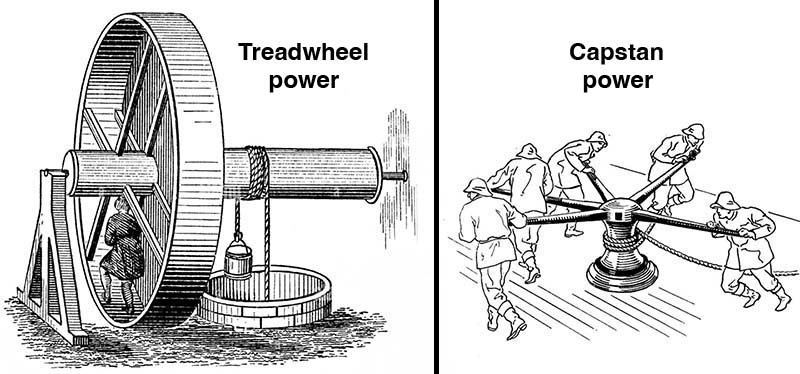
Above left, a person operating a treadwheel to draw water from a well; Above right, men pushing capstan bars to pull up a rope on a ship.
In the Sydney mills built by Wilkinson and by Baughan, these power sources would have been connected to a pair of millstones via a set of gear wheels. The power produced by the treadwheel, or the capstan, drove the rotation of the upper millstone and ground the grain. Image sources: left, Thomas Ewbank (1849) A descriptive and historical account of hydraulic and other machines for raising water, ancient and modern. Internet Archive; right, Pearson Scott Foresman archives, Wikimedia Commons.
John Baughan (AKA: John Buffin, Baffen, Bingham)
John Baughan arrived in Sydney in 1788 on the First Fleet transport, Friendship, as a convict serving the final few years of his seven-year term.
Although previously married to Catherine Morgan in England, Baughan married Mary Cleaver in Sydney in 1788. They had three children.[5] He was granted a portion of land at Prospect Hill, west of Parramatta, in 1792.[6]
In 1793, Baughan undertook to construct a flour mill in Sydney, in competition with James Wilkinson. It was powered by a capstan – see illustration above right. David Collins wrote,
'John Baughan, an ingenious man, formerly a convict, had undertaken to build another mill upon a construction somewhat different from that of Wilkinson's, in which he was assisted by some artificers of the regiment. Both these mills were to be erected on the open spot of ground formerly used as a parade by the marine battalion.' [7]
Baughan's design, using a capstan driven by nine men, was successful, and Lieutenant-Governor Grose commissioned him to build an even larger version of his mill.
For his achievements, Baughan was granted another portion of land near Dawes Point in inner Sydney. He was appointed as an Overseer of Carpenters.
John Baughan died on 25 September 1797, aged about 43.
Read more about the mills constructed by John Baughan.
John Davis, the 'ingenious Irish convict'
In 1797, Governor Hunter was frustrated with the progress of the Master-Millwright, James Thorp, who was attempting build a windmill with the components Hunter had brought to Sydney from England. Then, Hunter discovered a man amongst the convicts, who seemed to be capable of doing a much better job. He wrote,
'Anxious as I was to get a mill erected, I coul'd not effect it until I found an ingenious Irish convict, who has finished a very good one, and as an encouragement I gave him £25.' [8]
This was John Davis, who built the first working windmill in Sydney.B
In spite of his achievement, the name of the 'ingenious Irish convict' was not mentioned in the official records. However, Collins account in 1802 named him as 'Davis the millwright', [9] and investigations by later historians identified him as the convict, John Davis. The mill that Davis built for Hunter in 1797 was the First Government Windmill, located at today's Observatory Hill, on the west side of Sydney Cove.
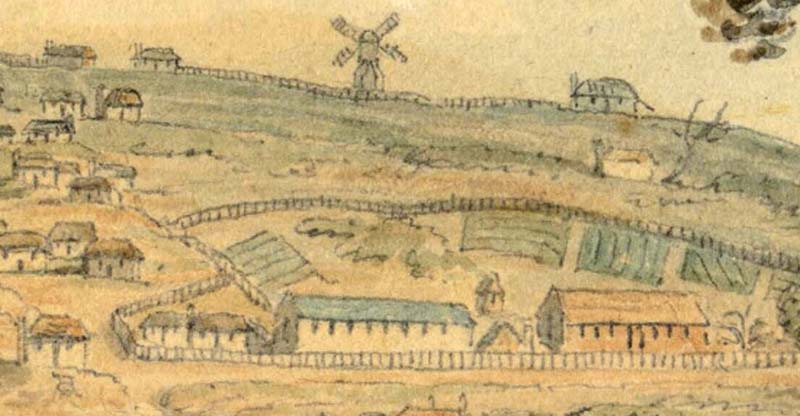
Above, Sydney's first successful windmill – the first Government Mill, built by John Davis near Sydney Cove. Detail from a watercolour painting by Edward Dayes, 'Western view of Sydney Cove, 1797', National Library of Australia.
Davis had been convicted of horse theft in County Monaghan, Ireland, and was sentenced to death. However, his sentence was commuted to transportation to NSW. He arrived in Sydney on 11 February 1796 on the Marquis Cornwallis. In November 1796, Davis married a fellow convict, Margaret Masterson. Later, in 1809, Davis was granted a lease on 53 rods of land in Windmill Row near the site of his first windmill.[10]
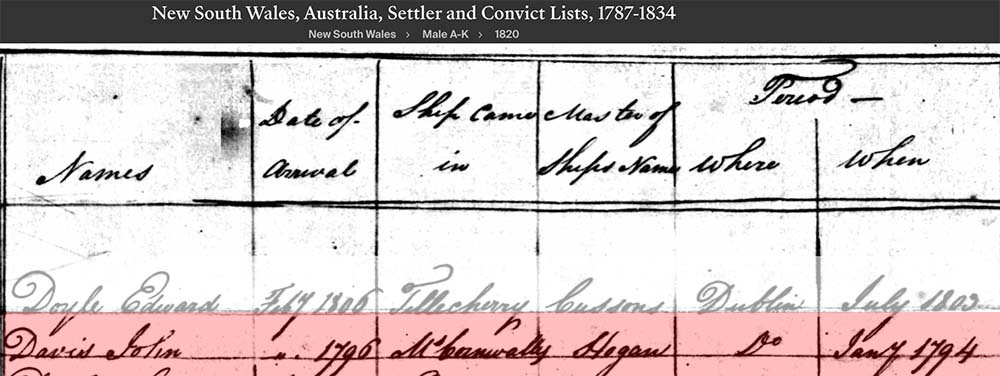
Above, details of John Davis' trial, sentence, and arrival in Australia were recorded in the NSW Settler and Convict List for 1820. According to this record, Davis arrived on the M. Cornwallis in February 1796, his trial was in Dublin in January 1794, and (the following page stated) his sentence of seven years' transportation expired in 1801. Resource archived on Ancestry website.
A terrible accident befell Davis in 1797 while working on this windmill. Collins related the story:
'Much rain fell during this month [April 1797]. On the morning of the 27th, a heavy squall of wind came on, which, for want of proper care and attention on the part of those employed at the wind-mill, set it going in such a violent manner, that while flying round with great velocity, one of the running stones was broken to pieces; one of which so severely wounded Davis the millwright in the head, that his life was despaired of.' [11]
Davis survived this injury but, at the age of only 42, he was disabled for life.[12]
On 5 February 1810, Davis wrote a memorial to Governor Macquarie, requesting a renewal of his land lease in recognition of his service to the Government as a millwright. It contains an interesting personal account of his life and work:
'To his Excellency Lachlan Macquarie Esq Captain general and Governor in Chief in and over His Majesty's Territory of New South Wales and its Dependencies The humble petition of John Davis Most Respectfully Herewith That Your Excellency's Petitioner is fourteen years in the Colony as a Millwright and Miller by Profession was the first man that constructed Windmills in this Colony for Government, has had the Misfortune of being Deprived of ever Enjoying the use of his Limbs which Accidentally happened in Prosecuting the duty Required by his Employ by one of the mill Stones which broke and fell on Pet[itioner] which Misfortune Renders him an Object to Excite Humanity during his Natural Life. That His Excellency Governor Hunter was pleased on consideration of Pet[itioner]'s misfortune to him a House and garden in Windmill Row which is an Aid Towards his Support and his Honour Lieut-Governor Paterson was pleased through Pet[itioner]'s disaster and Utility to Government when in his Strength to grant him a Lease of the afore[said] House and premises most humbly hopes Your Excellency will be pleased to Renew his Lease… and as in duty bound will Ever Pray John Davis' [13] |
By the end of 1797, it appears that Davis had recovered enough from his accident to superintend building the Second Government Windmill in Sydney. There are four intriguing records in the Historical Records of Australia, in annual reports of the work done in the colony from 1797 to 1800. The work of a millwright was listed in each case, and he was described as,
'A disabled man ; superintending the building of the new windmill.' [14]
Do these items record the ongoing work of our 'ingenious Irish convict', John Davis, following his catastrophic accident in his first windmill?
In the 1806 General Muster of NSW, Davis was listed as a 'very infirm' millwright, who had arrived on the 'M. Cornwallis'.[15]
John Davis died in Sydney in December 1813, aged 68. Margaret, his wife, served out her sentence in the Colony. In the Muster of 1825, she was recorded as an inmate of the Benevolent Asylum in Sydney.[16]
Read more about the mills constructed by John Davis.
B: Sydney's First Windmill. Nathaniel Lucas had already built a working windmill, as well as a watermill, in 1795 on Norfolk Island – at that time an outpost colony of NSW. However, John Davis' mill was the first working windmill to be built in mainland Australia and Tasmania.
Mill building progress in Sydney after 1800
The five millwrights, described above, had struggled against massive challenges to establish early flour mills in Sydney. Nevertheless, when Phillip Gidley King became Governor of NSW in 1800, he was deeply concerned about the shortage of efficient large-scale mills in Sydney.
Previously, during King's years as Commandant of the outpost penal settlement on Norfolk Island, (1788-1790 and 1791-1796), he had worked with a very skilful, convict carpenter named Nathaniel Lucas. In the mid 1790s, Lucas had constructed a large watermill and two windmills on Norfolk Island, and he became an experienced millwright.
Read more about Nathaniel Lucas, and the early mills on Norfolk Island.
In 1805, King asked Lucas to move to Sydney to construct flour mills there. Lucas brought with him, from Norfolk Island, several pairs of Norfolk Island Calcarenite Limestone millstones, and the workings of two windmills. Lucas went on to construct several successful flour mills in Sydney, until his death in 1818.
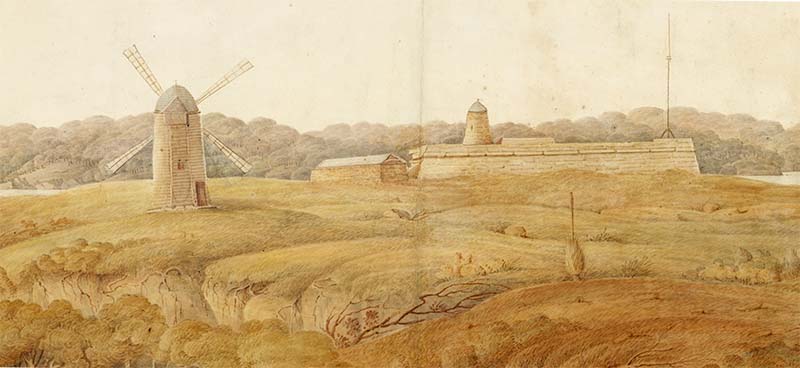
Above left, the smock windmill built by Nathaniel Lucas near Sydney Cove in 1805. This was Sydney's third Government Mill and it used millstones quarried on Norfolk Island. Detail from a painting by Major James Taylor in ca. 1819–1821, 'Parramatta River Sydney Harbour', State Library of NSW.
From 1800 onwards, quite a number of private millwrights became involved in constructing flour mills in Sydney, and these mills were operated by an increasingly large number of skilled local millers. Sydney gradually became capable of producing adequate flour supplies to feed its growing population into the future.
However, it was only thanks to the ingenuity, skill, and hard work of the five early mill builders described on this page, that the settlement of Sydney survived its desperate shortage of flour mills in the 1790s.
Can you provide more information We welcome contributions! Please Contact Us. |
REFERENCES
Abbreviations:
HRA – Historical Records of Australia. https://nla.gov.au/nla.obj-442186184
HRNSW – Historical Records of New South Wales. https://nla.gov.au/nla.obj-343230396
1. Collins, David (1798) An account of the English Colony of NSW. Volume 1. London.
2. Tatrai, Olga (1994) Wind and watermills in old Parramatta. Marrickville, NSW, page 28.
3. HRNSW, 12 October 1793, Vol 2, page 69.
4. Tatrai, Olga (1994) Wind and watermills in old Parramatta. Marrickville, NSW, page 21.
5. Dictionary of Sydney, https://adb.anu.edu.au/biography/baughan-john-1755
6. HRA, 17 October 1792, Series 1, Vol 1, page 401.
7. Collins, David (1798) An account of the English Colony of NSW. Volume 1. London.
8. HRA, 25 June 1797, Series 1, Vol 2, page 31.
9. Collins, David (1802) An account of the English Colony in New South Wales. Volume 2. London.
10. Hall, Barbara (2000) A desperate set of villains. Self published.
11. Collins, David (1802) An account of the English Colony in New South Wales. Volume 2. London.
12. Futcher, Cassie (2003) John Davis' windmill. History: the Magazine of the Royal Australian Historical Society, 75: 20-21.
13. Memorial from John Davis to Governor Macquarie, 5 February 1810, Colonial Secretary's Papers, 1788-1856, Fiche 3003, Memorial number 83b. Accessed from Ancestry.com.au Image number 124. https://www.ancestry.com.au/imageviewer/collections/1905/images/32086_228284__0001-00000?usePUB=true&_phsrc=ghk803&pId=161101
14. HRNSW, Vol 3, pages 338, 523, 752, and Vol 4, page 283.
15. New South Wales General Muster, 1806. Archived on Ancestry.com.au. https://www.ancestry.com.au/imageviewer/collections/1185/images/IMAUS1787_114235-00527?usePUB=true&_phsrc=ghk792
16. Hall, Barbara (2000) A desperate set of villains. Self published.
Read More About Sydney's Early Flour Milling History
•• Overview •• Sydney's First Millstones •• Australia's Colonial Millstones ••